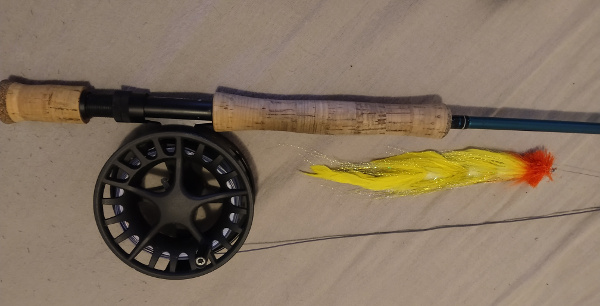
Fly fishing for pike and musky is a thrilling experience. The strikes can be savage, the fights explosive, and it can be all over in a matter of seconds. Fly fishing musky also differs greatly from most fly fishing, let me teach you how to target pike by fly fishing
Hooking into big esox (genus name for pike and musky) involves long days chucking oversized flies. Fishing this way is not enjoyable using a typical fly fishing rig, and requires specific equipment. Let me share with you my fly fishing setup for targeting big esox fish.
If you’re interested in learning more about fly fishing for pike and musky, see below:
Best Flies for Targeting Pike and Musky
Pike and Musky Fly Fishing Leaders
Quick note: I’ll be using the term pike or musky interchangeably below, rather than saying “Pike and Musky” every time.
This post uses Amazon Links. I receive a commission from any sales at no additional cost to yourself.
Fly Line
Choosing the right musky fly line is critical. The fly line is by far the most important part of any pike and musky setup, so this is where I’ll start. I use both a floating and sinking line when fishing for musky.
Floating/Intermediate Line
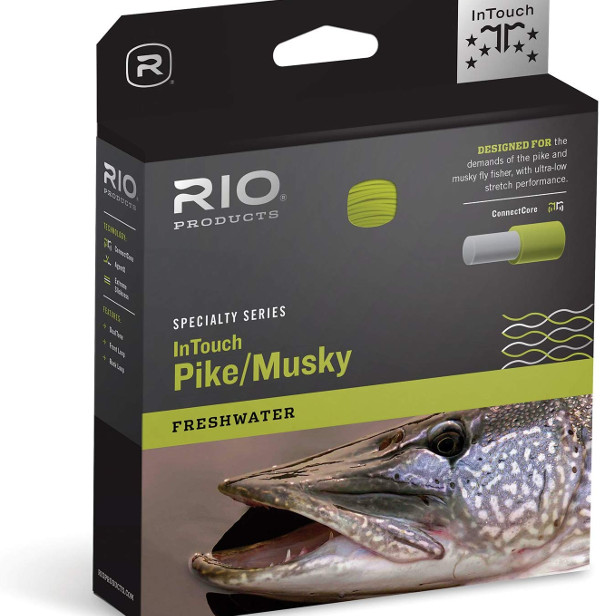
The topwater flies used in musky fly fishing are buoyant enough that floating and intermediate lines are nearly interchangeable.
I went with a full floating pike fly line. This helps with line control while wading. As mentioned earlier, intermediates have a very slow sink rate, and this sinking line can get tangled around your legs while wading. If I was fishing from a boat I would have gone with an intermediate as it’s more versatile.
The line I use is Rio’s WF10F Intouch Pike/Musky line. This line isn’t as enjoyable to cast as the Sonar Titan I’ll mention later, but it does a very good job of chucking poppers and other large topwater flies.
If you’re looking for a typical “fly cast” feel, this line isn’t for you, but if you just want something capable of chucking heavy foam head poppers, this will do the trick and has so far served me well.
RIO Fly Line Intouch Pike/Musky (Amazon Link) Make sure to change the size to match the rod you’re using before ordering. I went with a 10 weight to match the Redington fly rod I’m using.
Sinking Line
I use a sinking line 90% of the time in all my fly fishing, and pike fishing is no different. The sinking fly line I use for musky is Sonar Titan by Scientific Anglers, specifically in Hover/Sink 2/Sink 4.
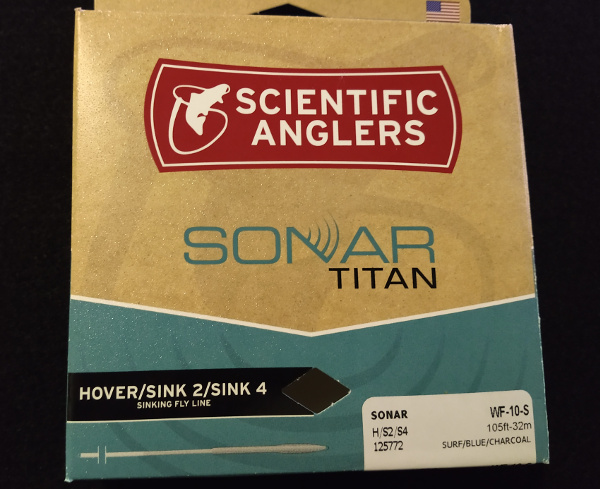
The fly line casts beautifully (for a musky rig). I can cast 8″ flies all day with much less fatigue than the floating line mentioned earlier. This is important as a big part of fishing musky is covering water, so long days are common if you want to hook into a big fish.
You need a faster sinking line than most other subsurface fishing as the large deer hair flies used in musky fishing want to float, so the fly line needs to drag them under the water. Most of my musky fishing is done in rivers, so I don’t want to go overboard with the sink rate. A line that sinks too fast will just drag on the bottom, damaging the line and causing snags.
The Sonar Titan Hover/Sink 2/Sink 4 does a great job of getting big flies down, without dragging on the bottom. If you’re fishing lakes, or other deeper water, there’s a faster version of this line called the Sonar Titan Int/Sink 3/Sink 5.
You can get both versions of the lines below. Again, make sure you get the right line for the rod you’re using. I went with a 10 weight.
Scientific Anglers Sonar Titan Taper Hover/Sink 2/Sink 4 (Amazon Link)
Scientific Anglers Sonar Titan Int/Sink 3/Sink 5 Fly Line (Amazon Link)
For reference, about 70% my musky fishing is done in the Ottawa and Rideau rivers.
A note on line management:
Some wading fly anglers may prefer to go with a sink tip rather than a full sinking fly line as listed above. The main drawback of using a full sink line is that the fly line loops will sink and may become tangled around your legs. This is concern is made even worse in water with any sort of current.
This is not an issue at all if you are fishing from a boat though.
I really like the way a full sinking line gets a fly down deep and presents the fly though. I’ve learned to improve my line management techniques to compensate for having line constantly floating around my legs. Be mindful of where the line is, and try to place the excess line downstream from where your standing. a line basket (Fly Fishing Basket (Amazon Link) can help if you find the line is getting tangled too often.
Alternatively, Titan does make a sink tip fly line.
Scientific Anglers Sonar Titan Sink TIP, WF10F/S3 (Amazon Link)
Fly Rod

The fly rod needs to be one that handles the heavy fly lines listed above, and is capable of fighting aggressive fish. After significant research, I decided to go with the Redington Predator fly rod. I’ve been thrilled with the rod since buying it.
The Redington Predator comes in a range of sizes and specialties, ranging in size from a 5 weight for chucking trout and smallie streamers to the ridiculously heavy-duty 16 weight for targeting tuna and marlin.
Redington makes two rods specifically designed for Esox Fishing:
- The “PIKE” Rod, which is a 10 weight.
- The “MUSKY” Rod which is a 11 weight.
I elected to go with the 10 weight “PIKE” rod for a few reasons. I purchased this with musky fishing specifically in mind, but with the expectation to target pike with it as well.
I mostly wade, rather than fish from a boat. This means that most of my fishing is done in rivers rather than lakes or ponds. There are a few reasons why spending more time fishing rivers means I choose a smaller rod:
- Average baitfish size in rivers tend to be smaller than lakes, resulting in throwing smaller flies. The flies I throw are 6″- 10″ on average vs the 12″+ often used in lakes.
- Musky in rivers tend to be smaller than lakes. There are exceptions to this rule though (The Ottawa River and St Lawrence have some of the biggest and best musky fishing in the world for example).
- I spend long hours fishing, and larger rods make you tire more quickly. For the sake of my casting arm, I elected to go with the smaller 10 weight.
REDINGTON Predator Pike 1091-4 Fly Rod Outfit (10wt, 9’0″ 4pc) (Amazon Link)
Many people ask about overlining (putting a 11 weight line on a 10 weight rod for example). This has the effect of slowing down the action of a rod. While I like slower action for certain types of fishing (as it can improve line control), fast action rods are ideal for fighting musky and chucking big flies (especially in wind). So I don’t see the need to overline when setting up an esox rig.
Fly Reel
While the fly reel isn’t as critical as the other components in the setup, it’s still not something you want to cut corners on in esox fishing.
Drag is not important in the same way most fly anglers are used to. Esox do not make long, finger burning runs tearing line off the reel like steelhead or carp do. Instead, fights with musky are short but explosive, with plenty of head thrashing.
So you don’t need a reel with drag capable of stopping a freight train, just one with a decent smooth drag system that will not fetch up while the fish is thrasing. If the drag skips or gets stuck during the fight, all the stress of the head thrashing is suddenly transferred to other components of the rig. This increases the likely hood of the pike breaking off and damaging the weakest part of the setup.
So a poor drag can result in straightened hooks, broken leaders, damaged fly lines, or even (worst case scenario) a broken fly rod.
After drag, the most important part of a reel to me in esox fishing is versatility. I’m a big fan of reels with interchangeable spools. The best value for your money is the Lamson Liquid or Remix.
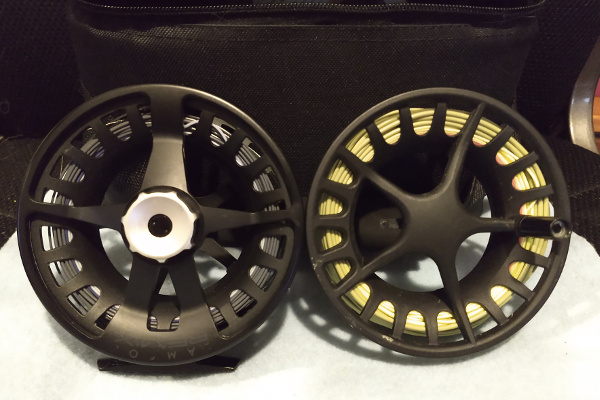
These reels come with three spools, which means you don’t have to purchase entirely different reels if you want to use several different types of fly lines. Pictured above is the reel and one of the two spare spools.
I have a floating line on one spool and a sinking line on the other. The third is a backup, and I’ll probably fit it with a sinking line of a different sink rate for versatility. This allows me to quickly swap spools with fly lines already installed, and easily switch from fishing topwater to subsurface.
Lamson Liquid 2 Reel w/ extra 2 Spools (Amazon Affiliate)
The Liquid and Remix are basically the same reels, the only difference is that the liquid is entirely cast metal while the Remix has cast metal spools and a machined metal case (with higher grade aluminum). This means they function the exact same, just the casing of the remix is a bit more durable.
Leaders
This is the part of the pike fly fishing setup that gave me the most difficulty when I started fishing for toothy critters. There are many different opinions on what the best leader is for pike and musky, both in fly fishing and conventional angling.
I go into great detail on the subject of esox leaders for fly fishing here.
Backing
Even though esox don’t typically pull a ton of line, they are certainly capable of it. These fish are anything but predictable, and I’ve had a few pull enough line to take me into the backing. So you need backing strong enough to handle the fish you’re targeting. You certainly don’t want the backing to let go and the fish swim off with your fly, leader, and fly line.
There are many backings that will work. I purchased 300 yards of RIO’s 50lb backing, and am happy with it. Since I use the Lamson reel system with three spools, this gave me 100 yards per spool. I judged that to be more than enough for esox fishing and haven’t run into any issues yet.
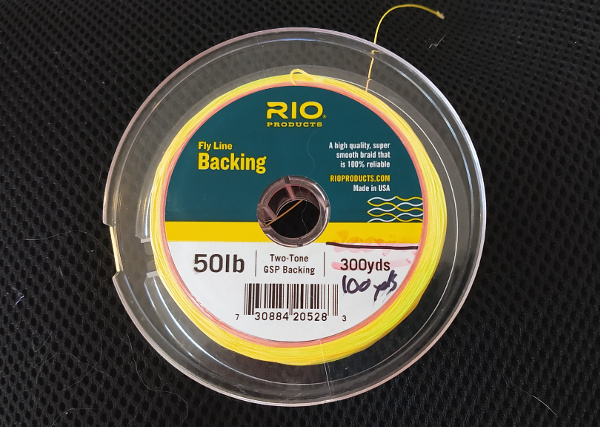
As you can see above, I’ve used 200 yards so far. The other 100 yards is waiting for me to purchase another fly line for the third spool.
Rio Fly Fishing Backing 50Lb 300 yd (Amazon Link)
Flies
I go into significant detail on some of the best fly patterns for targeting musky and pike here.
If you are just looking for a quick summary though, I will say the most commonly recommended fly for each species:
Musky: Buford Streamer
Pike: Pike Bunny.
Additional Equipment Needed
There are a number of other items aside from the actual fishing setup that are absolutely essential when targeting pike.
Pliers/Forceps
You do not want to stick your hand in the mouth of an angry pike. A good pair of pliers or forceps will allow you to remove the fly much more easily. I really prefer long-nosed, curved nose pliers. These pliers allow you to deeper into the muskies mouth without putting your actual hand in there.
The added bonus of having a pair of pliers is that you can squash the barbs of any flies before fishing them. Most musky fishing is catch and release, so the use of barbless hooks is very much recommended. It makes removing the hooks much easier. Barbless hooks are also much easier on the fish, ensuring a successful and healthy release.
I quite like forceps/hemostats rather than pliers myself. They’re lighter, and find they do a good job of holding onto hooks. They also tend to be a bit cheaper than pliers.
The only drawback is they are not great at pinching barbs. I just make sure to pinch all the barbs of my flies as I’m tying them though.
Fishing Hemostat Plier, 2 Size Combo (Amazon Link)
Jaw Spreaders
Every once in awhile, you’ll get a pike that just refuses to open their mouth. This is when it’s absolutely necessary to have a good pair of jaw spreaders in your arsenal.
Even when the pike are relatively cooperative and open their mouth willingly, you don’t know how long that will last. A pair of jaw spreaders will prevent musky from bitting down when you’re trying to remove a hook.
I find no reason to go fancy with these, a cheap set works very well.
Fish Mouth Spreader 2 Pack (Amazon Link)
Wire cutters
Sometimes you just can’t remove the hook from the mouth. In this situation, it’s better to cut the hook than leave the whole fly in the fish’s mouth.
Wire cutters will also help extend the life of your scissors if you tie your own leaders. Cutting wire with scissors will quickly dull them, and wire cutters should really be used instead.
Optional Equipment
Boga Grip
Some people use a Boga Grip when fishing musky. It can be useful to maintain control of the head of the fish while you remove the hook. These are better than most lip grippers since they rotate, making it harder for the fish to both escape or damage themselves when thrashing.
When handling musky with a boga grip, avoid putting the weight of the fish on the boga grip, and keep the fish horizontal. The jaws can be surprisingly delicate and can break if forced to hold the weight of the entire fish.
Net
I say this is optional, but only in the loosest sense of the word. If you ever want to take the fish out of the water (like for a picture), then a large net really is essential for gaining control of the fish.
Camera
Trophy pike and musky are truly impressive fish. If you hook into a 50″+ musky, you’re going to want a picture. I typically fish solo, so I can’t get the typical trophy picture. My solution was to get a Go Pro and chesty mount.
I just keep the camera on idle and click the button when I get a bite. If you film all the hours you’re fishing, you’re gonna drain the battery. I also keep three back up batteries, and typically go through 2 or 3 of my total batteries in a day of fishing.
I use it with a chesty chest mount.
GoPro Performance Chest Mount (All GoPro Cameras) (Amazon Link)

7 thoughts on “Musky and Big Pike Fly Fishing Setup”